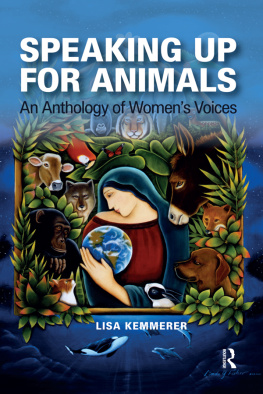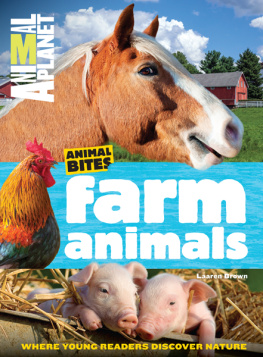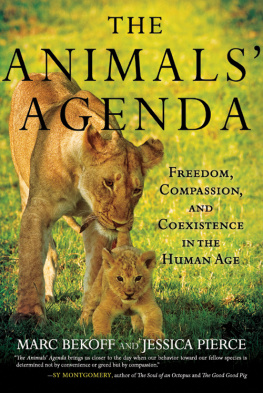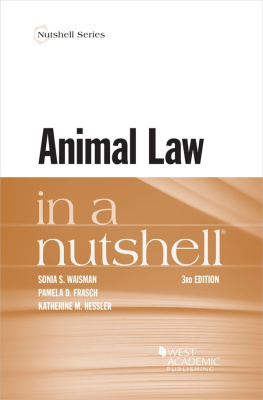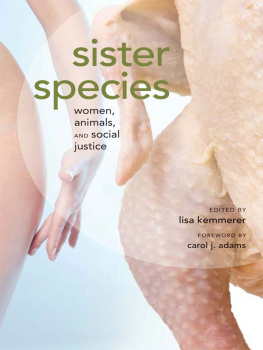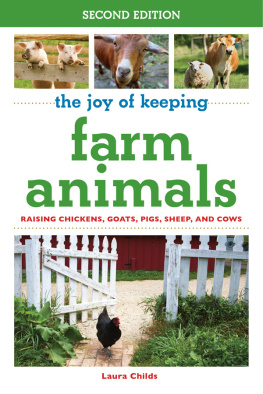First published 2012 by Paradigm Publishers
Published 2016 by Routledge
2 Park Square, Milton Park, Abingdon, Oxon OX14 4RN
711 Third Avenue, New York, NY 10017, USA
Routledge is an imprint of the Taylor & Francis Group, an informa business
Copyright 2012 Lisa Kemmerer
All rights reserved. No part of this book may be reprinted or reproduced or utilised in any form or by any electronic, mechanical, or other means, now known or hereafter invented, including photocopying and recording, or in any information storage or retrieval system, without permission in writing from the publishers.
Notice:
Product or corporate names may be trademarks or registered trademarks, and are used only for identification and explanation without intent to infringe.
Library of Congress Cataloging-in-Publication Data
Speaking up for animals : an anthology of womens voices / edited by Lisa Kemmerer.
p. cm.
Includes index.
ISBN 978-1-61205-087-4 (hardcover : alk. paper) ISBN 978-1-61205-088-1 (pbk. :
alk. paper)
1. Animal rights movement. 2. Animal rights. 3. Animal welfare. I. Kemmerer, Lisa.
II. Title.
HV4708.S625 2011
179.3dc23
2011022818
Designed and Typeset by Straight Creek Bookmakers.
ISBN 13: 978-1-61205-087-4 (hbk)
ISBN 13: 978-1-61205-088-1 (pbk)
I am grateful to the women in this anthology for their courageous commitment to animal advocacy, and for sharing their stories, experience, and expertise. The social justice work undertaken by these womenand by thousands of other animal advocates around the worldis among the most difficult of undertakings. But such work is essential if we are to move toward justice.
I dedicate this book to animal liberationists everywhere, and to the animals who anxiously await reprieve from their ongoing suffering.
Special thanks to my sister, Jan, for suggesting that I create this anthology, and for locating contributors. Also many thanks to a fellow activist and friend, Alex Bury.
Carol J. Adams
In her important book on violence and its consequences, Trauma and Recovery, Judith Herman writes, All the perpetrator asks is that the bystander do nothing. He appeals to the universal desire to see, hear, and speak no evil. The victim on the contrary asks the bystander to share the burden of pain. The victim demands action, engagement, and remembering. I have lived with these powerful words for almost two decades now, and, to me, they underscore why individual activism matters; it matters because the victim demands action, engagement, and remembering.
In this book you will encounter stories from the lives of women who understood at a deep, personal level just what this means. You will find eighteen individual stories of action, engagement, and remembering.
Lisa Kemmerer has done a magisterial job of identifying some of the different paths in which women have expressed their engagement, refined their activism, and remembered, always remembered, why they are doing this. Or rather, for whom they are doing this. They share the burden of pain: a thirsty pig, a thirsty downed cow, a goat with both of his ears cut off, a rescued turkey with an abscessed foot, a baby seal crying ma. They work for the Taiping Four (illegally imprisoned gorillas), and Ruby the rust-colored ape. They sing with gibbons, and cradle a dying elephant. They spend years negotiating the release of two sun bears, Ompoom and Apec. They nurse a slow loris whose leg was amputated after being caught in a snare. They remember the dusky Brown Swiss cow who adopted two orphan calves. They remember the frightened pig who jumped from a pile of carcasses but was knived before they could reach her. They recognize that screaming parrots in pet-store cages, tigers roaring in zoos, swaying elephants in exhibits, lions howling in grief after their companion is killed by park rangers are not just unhappy animals but souls in anguish from human-imposed suffering. Even their attitude toward insects changes.
In these pages are the testimonies of eighteen women I deeply admire. Some are women whose work I know well, some I am meeting for the first time; but each of them, in their unique voice, has something to teach us. Yes, I hope you will feel inspired, as I have been, reading their stories. But their stories are more than inspiring. They expand our sense of what is possible and they affirm how much any individual can help to challenge evil. Because they have seen, heard, and engaged with evil, they show us not only that it can be done, but how to do it.
Along with the women whose voices are represented here, I do not believe it is the job of the human to be the voice of the animals; rather it is the job of the human to hear the wide variety of animals voices, and to help us hear what the animals experience. I love the voices and the tone, and the subtle humor in these pages. In graphic, yet poetic descriptions, we experience beautiful lives in which engagement is the logical outcome of refusing to be a bystander. They refuse to accept the aroma of suffering.
I love the affirmation we can find in the writing itself against the depressing and overwhelming situations into which the authors have placed themselves. Watch for Patty Marks comment he had noticed our good work! Its the kind of humor I find in a Jane Austen novel, and makes me appreciate all the more that she has retained her humor even when she is placing herself in dangerous situations.
R EFUSING TO B E A B YSTANDER
Why? Why did these women overthrow their lives and place themselves in the midst of incredible evil? Why did they stand up against the perpetrator? How did they learn to dismantle a duck bind; to feed an emaciated elephant or seal; to run a sanctuary; to oversee spaying and neutering of dogs and cats; to dress in such a way as to go undercover in oversized scrubs, big rubber boots, ridiculous safety glasses, and backpacks that hold essential gear for videoing in a vivisection lab?
If you dont know it yet, it is hard to discover you are a bystander. Many of the stories include memories of a time when the author failed to act. (Of course, the fact that many of these instances occurred when they were children or teenstimes in our lives when we are incredibly disempoweredis an important factor.) They saw a dog being beaten; they saw hundreds of thousands of hens crowded together in small, decrepit wire cages, and ran out of the shed; they worried for a puppy left alone as the family went on an extended trip, a neighbors dog outside on a short chain in all kinds of weather; they saw a cow shot in the throat bleed to death; they heard little lambs bleating as they died from slit throats; they saw a sheep being sacrificed to the president (as a little kid, president meant nothing to me, but that sheep did. )
And they recognized what it means to feel like a bystander and they knew , they knew that their failure to act had meaning.
Being a bystander burdens one with guilt. The question becomes could I have stopped what I just witnessed? They recognize how passivity protects the abuser, not the abused. And the answer becomes, I might not have been able to stop that specific act of cruelty, but I will take from this encounter of my passivity a reminder: I have the ability to help. What must I do? What can I do?

